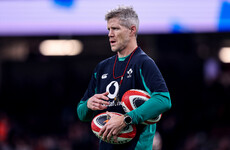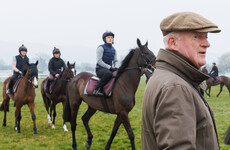MONDAY’S RUGBY WEEKLY is fresh out’ the oven and available wherever you get your podcasts.
With a laboured victory over Russia now firmly in the rear-view, and a super typhoon potentially on the horizon, Eoin Toolan and Murray Kinsella joined Gavan Casey on the line from Japan to kickstart the build-up towards Ireland’s crucial final pool fixture against Samoa.
The lads also gave their insights into two prime World Cup contenders in England and New Zealand, and where each of them are going right in their pursuit of a second and fourth World Cup respectively.
As for where Ireland have been going wrong, performance analyst Eoin provided a typically expert breakdown, but explained how if Ireland can iron out their basic errors in lower humidity, they could still be in with a shout at the quarter-final stage and beyond.
You can listen to the full podcast on iTunes or your regular podcast provider, or at the link at the bottom of the page.
Eoin: “Undoubtedly, one of the key components of Ireland’s attack is the attritional nature of it, and how a huge dependency is placed on their tight five and their back row in terms of ball-carrying.
“Even if you look at the Russia game, Ireland’s top two ball-carriers were Tadhg Beirne and Rhys Ruddock. I think their tight five carried 56 times in the game. I think this is a key point which could be relevant to the fatigue that Cian Healy is talking about: of those 56 carries, they only averaged [0].69 metres per carry — so not even a metre per carry, which could give a sense of a high level of fatigue or it could be a byproduct of other teams getting on top of Ireland’s attack in those channels. But I thought that was really interesting.
“When I looked at other teams from the weekend, the biggest game was England-Argentina. Top ball-carriers: Elliott Daly, Johnny May — followed by Kyle Sinkler, but obviously two outside backs there. In the New Zealand game against Namibia, the top ball-carriers were Jordi Barrett, Jack Goodhue, Anton Lienert-Brown — all backs. And in the Japan-Samoa game, top three ball carriers were [Lomano] Lemeki, [Kotaro] Matsushima and [Ryohei] Yamanaka — all back-three players. So it kind of gives a real, clear snapshot of what the other teams are doing, that sense of width.
“You can see through the naked eye, that’s definitely where teams are trying to get the ball to with ball movement and width, and Ireland are definitely playing that narrower type of attack. And then, factor that in with some of the other data in terms of where Ireland rank in ball carries… So, on average, Ireland are ranked third of that group of countries that I talked about (Six Nations, Rugby Championship and Japan) for ball carries at about 137 per game. Australia are top with 151 and we know Australia really like that high-possession-based game, low-kicking-based game.
When you factor in that Ireland have a really high carry count in games, their clean breaks ranked among the other teams is about midway — it’s sixth of those teams that we’re talking about. And in metres made they’re well down the list — they’re down in eighth position. So it’s showing that while they’re having a high carry count, their effectiveness both in terms of metres made and defenders beaten has not been [high] in the first three games.
Gavan: “On the flipside, are there any positives to that attritional style of play, a reliance on the tight five that Ireland are bringing to the table, or is it actually pretty much a flaw in their makeup? For example, with that attritional approach, can you tire teams down, maybe, more so than if you were going wide the way some of the other top nations are doing at the moment?”
Eoin: “That’s a really key point, Gavan, because Ireland’s attacking shape is predicated on low error-rate, where they don’t allow opposition access points into the game. Their breakdown has generally under Joe Schmidt been so accurate that they do wear teams down and tend to pull penalties out of teams which then gives Ireland field position, allows them to get into those structured attacks — especially off lineouts, where again against Russia, Ireland brought out some old plays but inventive plays where they tend to destructure and break down defences.
“But especially in the Russia game again, humidity was definitely an issue in terms of the high error count. When Ireland are turning over possession then, it does make it very difficult for them to keep the foot on the throat and maintain that pressure. I think if you’re looking at what other teams are doing, particularly in their attacking shape, New Zealand and Japan are prime examples [in that] they’re bypassing that first forward pod off nine and trying to get that width or to the middle of the pitch as quick as they can. And then, rather than sending that forward pod that they’ve bypassed around the corner, that forward pod sets back on that near side and they’ll come and play it back to them.
But there’s definitely a genuine sense that other teams are being more efficient with their energy levels and using their attacking kicking game. When Ireland have used the attacking kicking game, particularly through Carty — there was a Sexton try at the weekend; the Sexton setup for the O’Mahony try — those attacking kicks are paying dividends for most teams in the World Cup. So the variation between your attacking kicks and not being so point-to-point in terms of the forwards you’re using to carry into contact is crucial for a team to be successful at the World Cup.
Gavan: “So it’s kind of a double-edged sword for Ireland, then, Eoin, is it? If your error count is high using that attritional approach, it’s going to basically negate what you’re trying to do whereas if you can keep the mistakes to a minimum as has been a hallmark of Ireland – or had been, at least, maybe last year – then it can still be an effective means of playing the game?”
Eoin: “Absolutely. Absolutely. And I think Joe’s talked about when the humidity wears down…
And humidity, to be honest, from being involved in Super Rugby for six years — humidity is worse than rain. The film that you get on the ball is far slippier than rain and it is very, very difficult to maintain possession. So if that humidity does drop and Ireland can get into more of a rhythm, and be really, really accurate with the ball, I think it’s a tactic that’s worked for Ireland and they’ve had a huge amount of success with it. So I don’t see why reverting back to that won’t draw success for them.
Eoin Toolan and Murray Kinsella join Gavan Casey to give an in-depth breakdown of where Ireland’s play stacks up against the contenders in Japan, and look into why New Zealand and England are primed for World Cup success.
The42 Rugby Weekly / SoundCloud











“One played in Rome yesterday” – ah c’mon Gary , surely you can poke the bear a bit harder than that
@Paul Burke: the Scotland players coming back is one thing but getting Murphy is a godsend for Glasgow.
You have to admire the strength and dept of Leinster .
Given the amount playing for Ireland yesterday to still be able to field that team is astonishing
Can’t think of any other club side with that playing pool .
Credit where credit is due.
So much for non-biased journalism! Should be writing for the Mirror!
Last paragraph is wrong (saying Leinster got try BPs in 11 or of 12 games). They got a try BP in the game lost to Connacht too. So 12 out of 12. Pretty impressive really.
@gpq: * ‘out of’
@gpq: munster stopped them from getting 4 tries
@Scott Crossfield: that’s another accolade to add to the trophy cabinet so
@Scott Crossfield: Yeah. You’re right. Was half asleep when I wrote that. Wasn’t thinking. That’ll teach me to try to be smart. 11 out of 12, then. Still pretty impressive though. And today 12 out of 13.
Next week will be tougher though. Most of the 1st team on national duty, only Henderson & Burns from Ulster, unless I’m mistaken again. And now H. Byrne & Frawley injured. Might not even win!!
Does anyone actually think this Rainbow Cup is actually going to go ahead? It’s going to be called off and we’ll have the same playoffs as every other year.